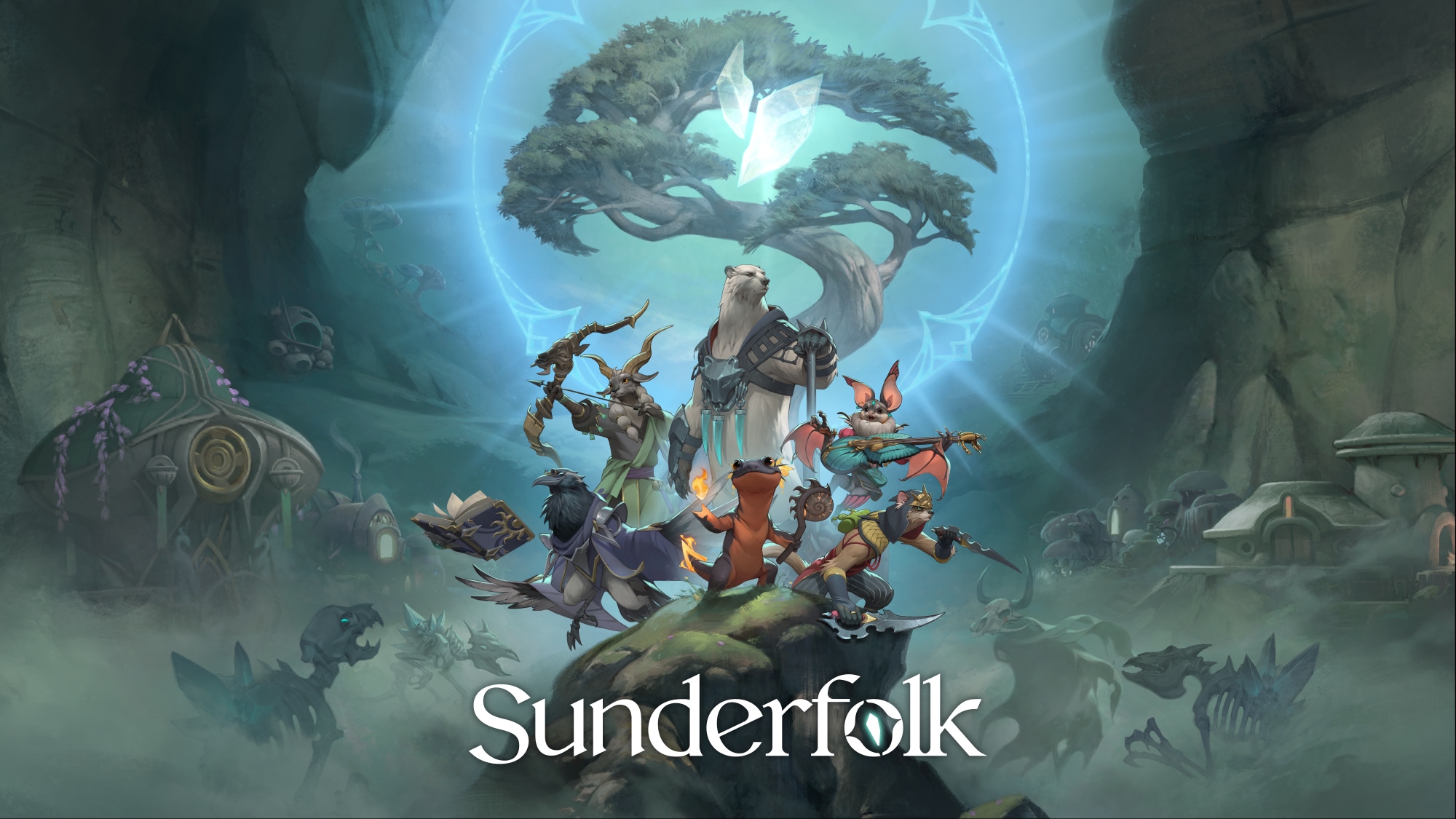Dreamhaven Studios provided a round-trip train from Washington, D.C. to New York and accommodation for one night so that Ars could play Sunderfolk and interview its creators. Ars does not accept paid editorial content.
Tabletop board games and video games typically offer ways to reduce their difficulty. But getting and keeping a group together for a semi-regular game night or impromptu session across different schedules and experience levels? That can be fiendishly hard.
That, more than anything, is what Sunderfolk wants to make easier. At its core, it’s a turn-based tactical RPG with well-worn hero classes and mechanics familiar to fans of crunchy tabletop games and CRPGs. But this upcoming game from Secret Door, led by Blizzard veteran and tabletop aficionado Chris Sigaty, wants to bring more people into the game-night fold. By fusing Jackbox-like accessibility with tabletop mechanics and letting the game do all the hard work, Sunderfolk aims to reduce learning curves, eliminate setup, and encourage game nights with friends.
Gameplay trailer for Sunderfolk, due out in 2025.
Also, you use your phone as a controller, connected to one “big screen,” local or remote. But it makes sense, and it worked, at least in the two hours I got to play Sunderfolk. The phone is both a controller and a replacement for all the cards, tokens, and other ephemera a tabletop player would have in front of them. And it allows for quick setup of couch co-op or screencasted play. Sunderfolk is a game that can make use of the QR-code-scanning, Discord-arranging skills many of us learned during the pandemic.
Sunderfolk—due out in 2025 for PC, Xbox, PlayStation, and Switch—is aimed at both video game and tabletop audiences. It’s a bold swing, and it might not have come from anywhere else but Sigaty and the developers’ refuge he works under.
On your turn, you can use your phone to choose between your actions and guide your character on the screen.
Credit:
Dreamhaven
Sunderfolk as a gateway to game night
Dreamhaven, the publisher of Sunderfolk, is what Mike Morhaime and his wife Amy are doing now after Morhaime left Blizzard, the company he co-founded, in 2019. Morhaime has teamed up with other Blizzard ex-pats to provide a unique kind of publishing house, one that offers equity to every employee and a great deal of autonomy to the two studios under the Dreamhaven umbrella so far.
Secret Door is one of those studios. It’s headed by Sigaty, the executive producer of Hearthstone, StarCraft II, and Heroes of the Storm and lead producer of Warcraft III. Fellow Blizzard veterans Jason Chayes and Dustin Browder head up Moonshot, the other Dreamhaven studio working on a game that, according to Sigaty, is quite different. Secret Door has its fair share of former Blizzard creators, too.
But Sigaty isn’t much for talking about the old days, at least with this new game to pitch. Throughout a formal presentation, an hour-long lunch, an hour-long panel interview, and every side conversation I had with him, he always came back to tabletop. Specifically, how great it is, how more people need to do game nights, and how Sunderfolk is Secret Door’s attempt to use the best parts of video games to deliver the best parts of tabletop while letting devices trim off the tough parts.
Kara Centell-Dunk, senior game designer on Sunderfolk, has a deep background in tabletop design. Part of her job is making sure people picking up the game don’t see how deep it is—at least right away.
“The further you get into tabletop games, the more you speak your own language,” Centell-Dunk said. “The deeper you get into the hobby, the harder it can be for you to pitch that hobby to other people… You start tossing around words like ‘worker placement’ and ‘drafting’ and ‘resource management,’ ‘Eurogame,’ ‘engine building.’” Sunderfolk has those things, but tries to get players familiar with them on a curve.
Along with the intimidating shorthand for newcomers, experienced tabletop heads face their own challenge: teaching new players the rules and helping them enjoy something new. “[People] don’t want to look bad in front of their friends, which I think is a really human instinct… The game will run most of itself, and I love that it was a way to invite players to try experiences I think they would love.”
If it works, Sunderfolk wants to get people on the couch, or, failing that, on Discord, working through turns, choosing hero builds, and, presumably, having a chance to talk about their non-mystical lives. I can’t say what it’s like over the long haul, but in a preview session with a fellow journalist and Centell-Dunk, I found myself getting the gist quickly, seeing meatier possibilities ahead, and, yes, getting to know two people who were utter strangers minutes before boot-up.
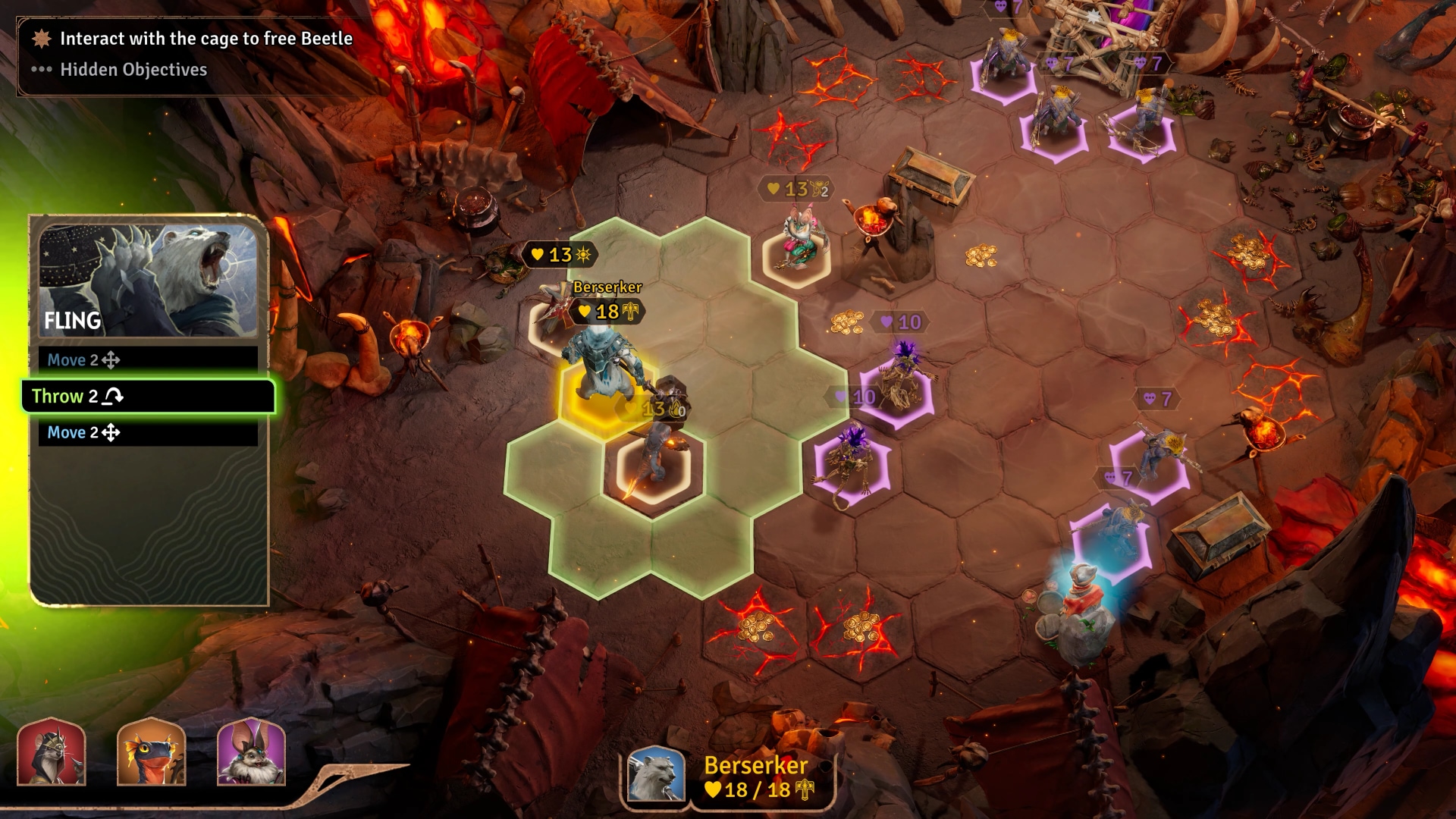
Two hours in the Sunderlands
Up to four people start out Sunderfolk by picking one of six heroes: arcanist, bard, berserker, pyromancer, ranger, or rogue. They’re anthropomorphized animals, so the berserker is a sledghammer-wielding bear, the rogue is a weasel, and the pyromancer is (I think) a fire-bellied toad (edit: a red-bellied newt, actually). The fantasy town you inhabit, Arden, and its central life-giving tree are under threat. Your band sets out into the Sunderlands to figure out what’s wrong and stop it.
Each mission takes place on a hex-based grid; you’ll be defeating baddies, rescuing innocents, and reaching other grid goals. As a group, you decide who goes next, and you can coach, argue, and even use a pointing device (Overview Mode) on your phone to map out ideas on the big screen (or just get up and point). When you’re ready, you tap to activate your turn, then use your phone to swipe between cards and trace out a path on the “big screen” to move. It’s weird at first, but after a few rounds, I could largely take my turns with barely a glance at my phone.
Playing with the berserker bear, pyro frog, and bird arcanist, my group both talked out strategies and engaged in some good-hearted Leroy Jenkins moments. The bird’s spells could really mess with enemies, but, like all RPG wizards, the bird was squishy. The bear’s movement was limited, but it could draw aggression and toss enemies around. My pyro frog was a glass cannon that demanded timing and zone control; I tried to spread fire around to trap enemies and boost future attacks while staying out of the melee.
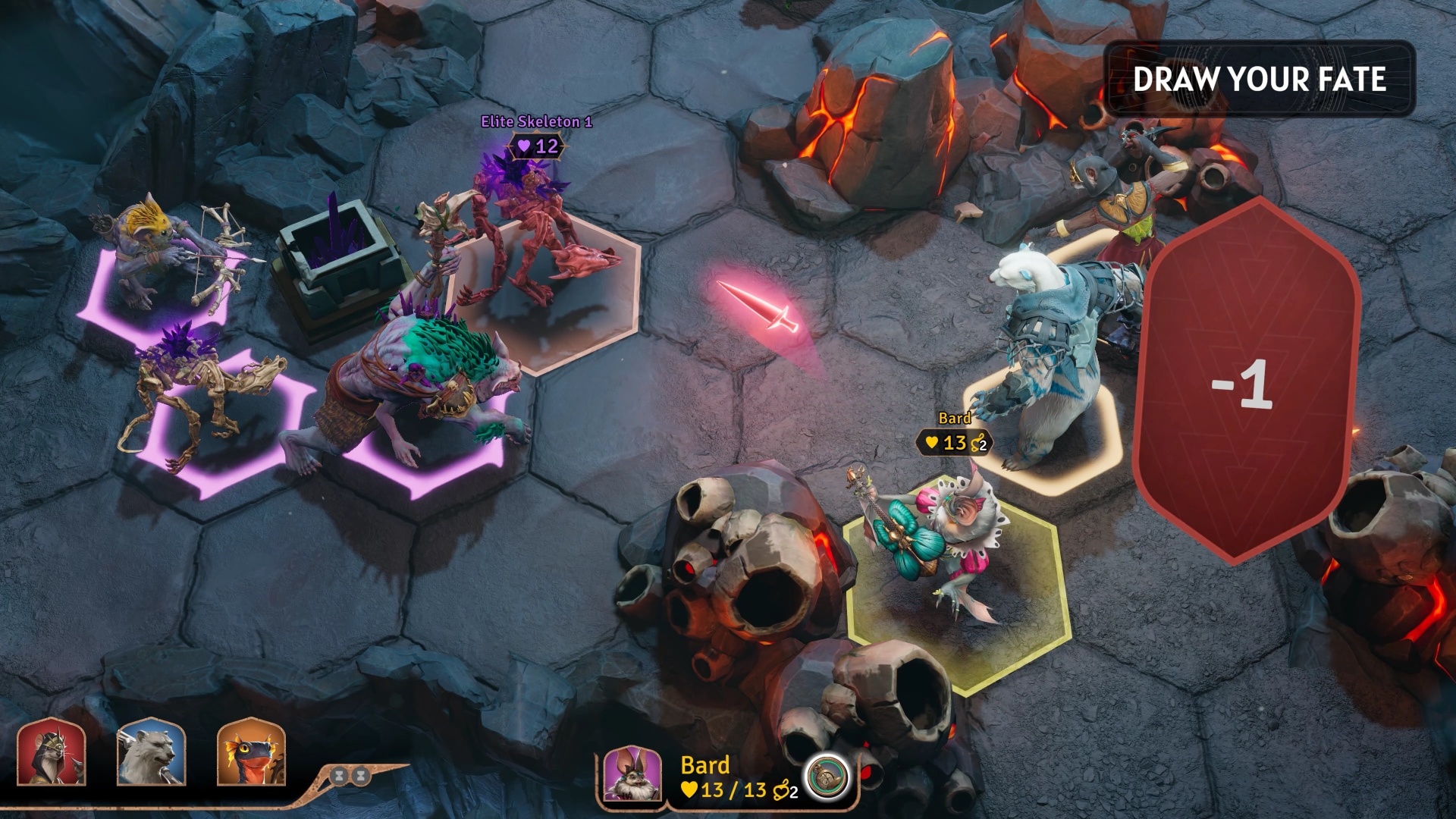
The Fate deck (at right), which early in the game is simple plus-or-minus modifiers but gets customized throughout a run.
Credit:
Dreamhaven
There’s a catch to each move, though, and it’s Fate. Each action has you draw from your Fate deck, which has a required number of positive, negative, and “other” cards. A card can add or subtract from your attacks, or change it up somehow, like modifying a dice roll. As you advance, you can alter this deck so that your worst negative outcome still gives you a bit of defense, for example, or a neutral Fate card heals you.
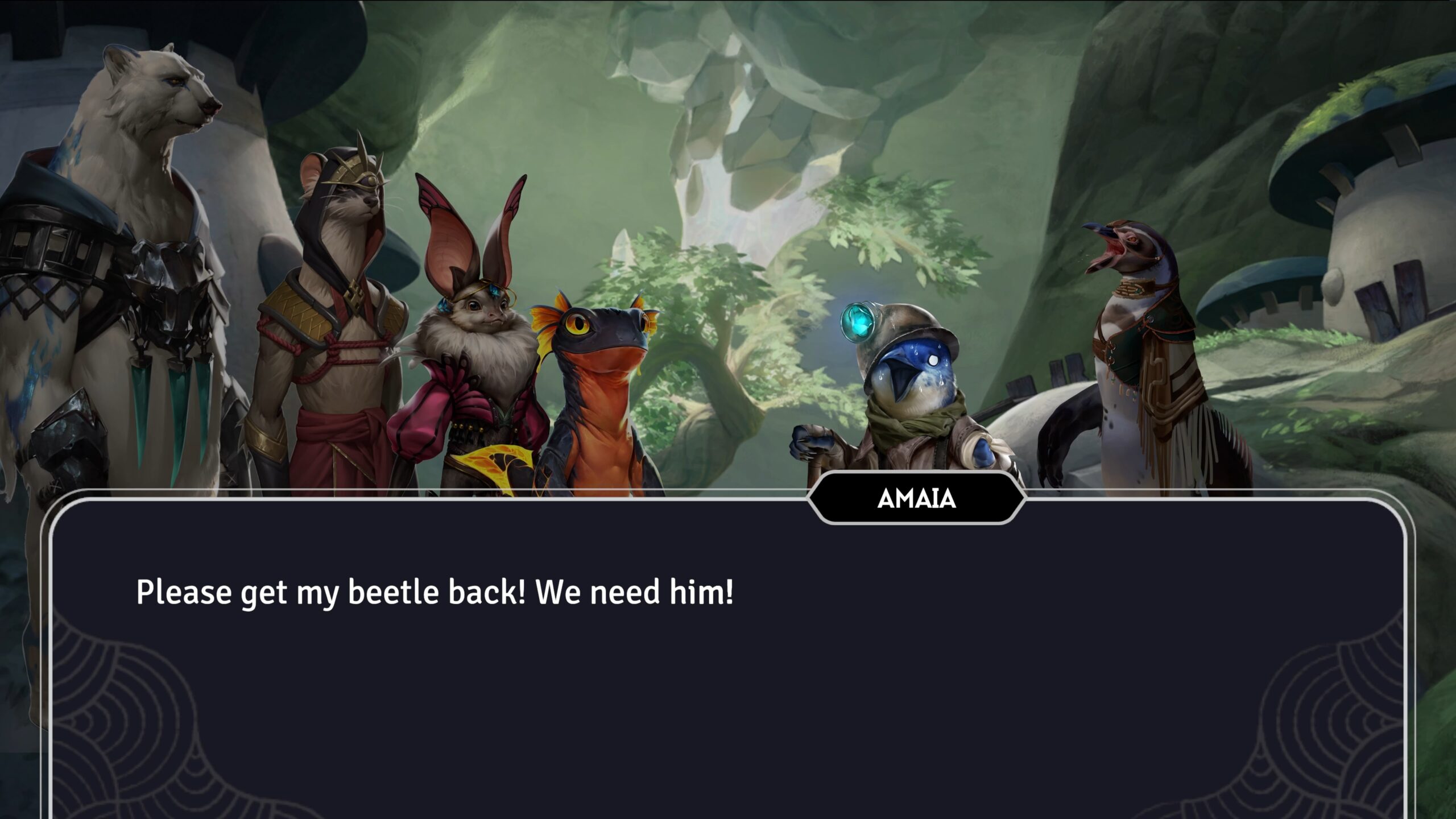
Fine, I’ll get you back your beetle, but only in exchange for experience points, randomly generated loot, and the chance to name him.
Credit:
Dreamhaven
On some missions, the game sends a chosen player a Madlibs-like prompt to name something in the mission. My own prompt led my team to valiantly rescue a kidnapped beetle named Michael Keaton. There were groans and grudging acknowledgments; it was the closest parallel to my tabletop experiences.
After each mission, you return to town where you get a little solo “maintenance” time, mostly on your phone. You level up if needed, visit people in town for some optional Stardew Valley/Dragon Age-style friendship maintenance, equip and sell Trinkets and other gear, decide where your party is heading next, and get some narrative.
I don’t know much of Sunderfolk’s narrative after just two hours and four missions. It’s linear, it’s appropriate for kids, and if you’re on a replay, it’s mostly skippable. Then again, Anjali Bhimani (i.e., Symmetra from Overwatch, Rampart from Apex Legends) does the majority of the voices here, so it’s not a hard listen.
The developers’ best guess is that the 38 missions currently in the game will take 25–35 hours on a first playthrough. The big variable, as with any game night, is how much “analysis paralysis” members of your group experience.
You can add new players and move on if a friend drops out, and people can play as other characters in a pinch (solo play would be running a minimum of two characters at once). Sunderfolk will do some auto-leveling for players who missed a session or two, and players can also gift gold or items to each other. The difficulties, adjustable at any time, span from “you pass out instead of die, infinite times” to “every creature is elite, death is real, and there’s a timer.”
Replayability should come from the side missions you didn’t choose last time, the range of characters and builds available, and weapons that can drastically change your play style (I didn’t get to those in my preview). The developers’ greatest hope is that players will want to introduce a wider range of friends to the game, ranging from casual gamers to Gloomhaven engineers.
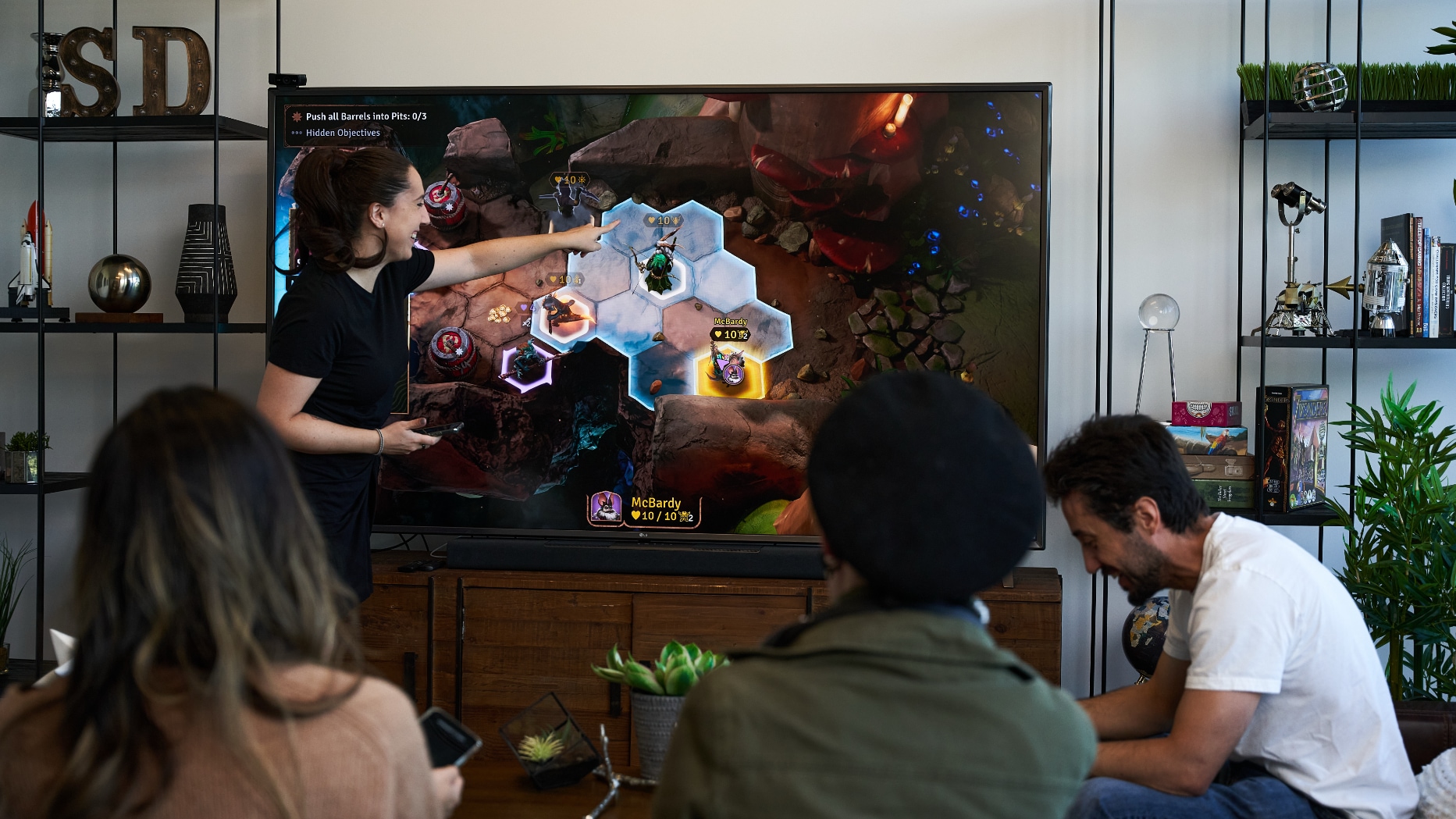
Sunderfolk is “Couch co-op first” and wants to get you and your friends talking about who should go next.
Credit:
Dreamhaven
Can Sunderfolk hit with two markets?
I asked Sigaty if, as a new 28-person studio, developing an original property for four platforms (plus mobile), Secret Door was “playing on hard mode.” He agreed and took it further, comparing Secret Door’s work to the fire triangle of heat, fuel, and oxygen. “New team, new IP, and new game. We did all three—and question our sanity a little bit.” But it was a conscious decision, Sigaty says, and a specific challenge.
“We’re trying to walk this really interesting line… If you come from this deeper board game side, you’ll find gameplay depth that’s there. And if you’ve never played these sorts of games before, you can get in and start playing and realizing this is something really fun,” Sigaty said. The world, too, is crafted to walk a middle line, having stakes but not being overly violent or sexualized. “We want families to be able to play together, too,” he said.
Then there’s the phone thing. There is no controller or keyboard option; you need an iOS or Android device with a touchscreen to play. Sigaty and his team say they’ve optimized the game for phone battery life. The game can also work fully on local network connections, leaving Secret Door’s servers only for remote play.
So only one person has to have the actual Sunderfolk game—displaying it on a TV, a Discord screencast, or wherever—while three others can scan a QR code and join by phone. As for the diminished sales potential that might present, Sigaty doesn’t seem concerned. Playing the game is its own marketing to own the game and bring in others, he suggested, similar to playing a board game and wanting to own it yourself.
I asked Sigaty how Secret Door plans to pitch a brand-new game to both tabletop and video game markets, perhaps simultaneously. “If there’s a story to Sunderfolk, it’s to walk the middle line,” Sigaty said. “My hope is… we can appeal to both audiences and say, ‘Both of you have a place here’ and act as this bridge to those people or their friends who never really played a tabletop experience before, or maybe never played a tactical strategy game on PC or console.”
This post was updated at 11:35 a.m. to note that the pyromancer character is likely a red-bellied newt, not a fire-bellied toad. Ars regrets its attempt at armchair herpetology.

